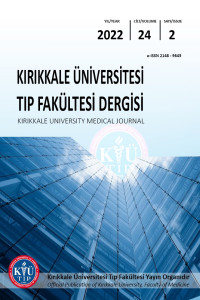Öz
Anahtar Kelimeler
kardiyak yaralanma şiddet indeksi Kalp yaralanmaları cerrahi penetran künt
Kaynakça
- 1. Kulshrestha P, Iyer K, Das B, Balram A, Kumar AS, Sharma M et al. Chest injuries: A clinical and autopsy profile. J Trauma. 1988;28(6):844-7.
- 2. Özkaynak B, Gümüş F, Polat A, Kayalar N, Erentuğ V. Cardiac trauma. JAREM. 2014;4(2):45-48.
- 3. Oakland C, Vivian J. Penetrating cardiac injuries. Br Med J (Clin Res Ed). 1987;295(6596):502.
- 4. Blatchford JW. Ludwig Rehn: the first successful cardiorrhaphy. Ann Thorac Surg. 1985;39(5):492-5.
- 5. Tokcan A, Yalınız H. Kalp yaralanmaları arşivi. Arşiv Kaynak Tarama Dergisi. 2003;12(3):260-8.
- 6. Keçeligil HT, Bahcivan M, Demirağ MK, Çelik S, Kolbakir F. Principles for the treatment of cardiac injuries: a twenty-two-year experience. Ulus Travma Acil Cerrahi Derg. 2009;15(2):171-5.
- 7. Göz M, Çakır Ö, Eren MN. Penetrating cardiac injuries: analysis of the mortality predictors. Ulus Travma Acil Cerrahi Derg. 2009;15(4):362-6.
- 8. Asensio JA, Stewart BM, Murray J, Fox AH, Falabella A, Gomez H et al. Penetrating cardiac injuries. Surg Clin North Am. 1996;76(4):685-724.
- 9. Aksöyek A, Tütün U, Babaroğlu S, Parlar AI, Ulus AT, Katircioğlu SF. Penetrating cardiac injuries. Ulus Travma Acil Cerrahi Derg. 2007;13(2):135-41.
- 10. Ivatury R, Nallathambi MN, Rohman M, Stahl W. Penetrating cardiac trauma. Quantifying the severity of anatomic and physiologic injury. Annals Surg. 1987;205(1):61-6.
- 11. Moore EE, Cogbill TH, Malangoni MA, Jurkovich GJ, Shackford SR, Champion HR et al. Organ injury scaling. Surg Clin North Am. 1995;75(2):293-303.
- 12. Karasu S, Tokat AO, Uzun HA, Kısacık E, Barlas AM, Baran NT. Penetrating cardiac injuries. Ankara Üniversitesi Tıp Fakültesi Mecmuası. 2010;63(4):115-8.
- 13. Campbell N, Thomson S, Muckart D, Meumann C, Van Middelkoop I, Botha J. Review of 1198 cases of penetrating cardiac trauma. Br J Surg. 1997;84(12):1737-40.
- 14. Gao J, Gao Y, Wei G, Liu G, Tian X, Hu P et al. Penetrating cardiac wounds: principles for surgical management. World J Surg. 2004;28(10):1025-9.
- 15. Asensio JA, Berne JD, Demetriades D, Chan L, Murray J, Falabella A et al. One hundred five penetrating cardiac injuries: a 2-year prospective evaluation. J Trauma. 1998;44(6):1073-82.
- 16. Buckman Jr RF, Badellino MM, Mauro LH, Asensio JA, Caputo C, Gass J et al. Penetrating cardiac wounds: prospective study of factors influencing initial resuscitation. J Trauma. 1993;34(5):717-25.
- 17. Ceviker K, Tulay C, Sahinalp S, Atlı HF. Factors affecting mortality in cardiac injury of penetrating thorax trauma: a retrospective study. Gaziantep Med J. 2014;20(1):35-41.
- 18. Moreno C, Moore EE, Majure JA, Hopeman AR. Pericardial tamponade: a critical determinant for survival following penetrating cardiac wounds. J Trauma. 1986;26(9):821-5.
Öz
Anahtar Kelimeler
Heart injuries surgery cardiac injury severity index penetrating blunt
Kaynakça
- 1. Kulshrestha P, Iyer K, Das B, Balram A, Kumar AS, Sharma M et al. Chest injuries: A clinical and autopsy profile. J Trauma. 1988;28(6):844-7.
- 2. Özkaynak B, Gümüş F, Polat A, Kayalar N, Erentuğ V. Cardiac trauma. JAREM. 2014;4(2):45-48.
- 3. Oakland C, Vivian J. Penetrating cardiac injuries. Br Med J (Clin Res Ed). 1987;295(6596):502.
- 4. Blatchford JW. Ludwig Rehn: the first successful cardiorrhaphy. Ann Thorac Surg. 1985;39(5):492-5.
- 5. Tokcan A, Yalınız H. Kalp yaralanmaları arşivi. Arşiv Kaynak Tarama Dergisi. 2003;12(3):260-8.
- 6. Keçeligil HT, Bahcivan M, Demirağ MK, Çelik S, Kolbakir F. Principles for the treatment of cardiac injuries: a twenty-two-year experience. Ulus Travma Acil Cerrahi Derg. 2009;15(2):171-5.
- 7. Göz M, Çakır Ö, Eren MN. Penetrating cardiac injuries: analysis of the mortality predictors. Ulus Travma Acil Cerrahi Derg. 2009;15(4):362-6.
- 8. Asensio JA, Stewart BM, Murray J, Fox AH, Falabella A, Gomez H et al. Penetrating cardiac injuries. Surg Clin North Am. 1996;76(4):685-724.
- 9. Aksöyek A, Tütün U, Babaroğlu S, Parlar AI, Ulus AT, Katircioğlu SF. Penetrating cardiac injuries. Ulus Travma Acil Cerrahi Derg. 2007;13(2):135-41.
- 10. Ivatury R, Nallathambi MN, Rohman M, Stahl W. Penetrating cardiac trauma. Quantifying the severity of anatomic and physiologic injury. Annals Surg. 1987;205(1):61-6.
- 11. Moore EE, Cogbill TH, Malangoni MA, Jurkovich GJ, Shackford SR, Champion HR et al. Organ injury scaling. Surg Clin North Am. 1995;75(2):293-303.
- 12. Karasu S, Tokat AO, Uzun HA, Kısacık E, Barlas AM, Baran NT. Penetrating cardiac injuries. Ankara Üniversitesi Tıp Fakültesi Mecmuası. 2010;63(4):115-8.
- 13. Campbell N, Thomson S, Muckart D, Meumann C, Van Middelkoop I, Botha J. Review of 1198 cases of penetrating cardiac trauma. Br J Surg. 1997;84(12):1737-40.
- 14. Gao J, Gao Y, Wei G, Liu G, Tian X, Hu P et al. Penetrating cardiac wounds: principles for surgical management. World J Surg. 2004;28(10):1025-9.
- 15. Asensio JA, Berne JD, Demetriades D, Chan L, Murray J, Falabella A et al. One hundred five penetrating cardiac injuries: a 2-year prospective evaluation. J Trauma. 1998;44(6):1073-82.
- 16. Buckman Jr RF, Badellino MM, Mauro LH, Asensio JA, Caputo C, Gass J et al. Penetrating cardiac wounds: prospective study of factors influencing initial resuscitation. J Trauma. 1993;34(5):717-25.
- 17. Ceviker K, Tulay C, Sahinalp S, Atlı HF. Factors affecting mortality in cardiac injury of penetrating thorax trauma: a retrospective study. Gaziantep Med J. 2014;20(1):35-41.
- 18. Moreno C, Moore EE, Majure JA, Hopeman AR. Pericardial tamponade: a critical determinant for survival following penetrating cardiac wounds. J Trauma. 1986;26(9):821-5.
Ayrıntılar
| Birincil Dil | İngilizce |
|---|---|
| Konular | Sağlık Kurumları Yönetimi |
| Bölüm | Makaleler |
| Yazarlar | |
| Yayımlanma Tarihi | 31 Ağustos 2022 |
| Gönderilme Tarihi | 3 Nisan 2022 |
| Yayımlandığı Sayı | Yıl 2022 Cilt: 24 Sayı: 2 |
Kaynak Göster
Bu Dergi, Kırıkkale Üniversitesi Tıp Fakültesi Yayınıdır.


